Wacky one-offs: the stories behind five track-day specials

Welcome to the world of the one-off specialWe meet the obsessives who have put blood, sweat and tears – not to mention thousands of pounds – into their mad, rad one-off track-day specials
In garages, workshops and sheds right across the UK, tinkerers and would-be mechanics get their fingers dirty.
Most undertake straightforward vehicle maintenance, while others restore bodywork or make running-gear modifications. A small number, however, squirrel themselves away for weeks at a time and only emerge once they’ve built something truly staggering. It might be a lightweight track car with two motorcycle engines, or a diesel supermini that’s faster than a modern super-saloon.
Welcome to the world of the one-off special – a world where people tend not to ask why but why not?
Seat Rosa drag car:
“You start off in second gear, engage the launch control system to hold the engine revs, then try to get the clutch release just right,” says Paul Lynas. “As soon as you let go of the clutch, it’s like being catapulted. That’s the only way I can describe it.”
Lynas is the driver of this Seat Arosa drag car, a Darkside Developments project. It was with him at the wheel that the Arosa recorded a quarter-mile time of 9.7sec at Santa Pod. It hit 60mph in 2.3sec and 100mph in a scarcely believable 4.8sec that day. For a while, it was the fastest front-wheel-drive diesel car on the planet.
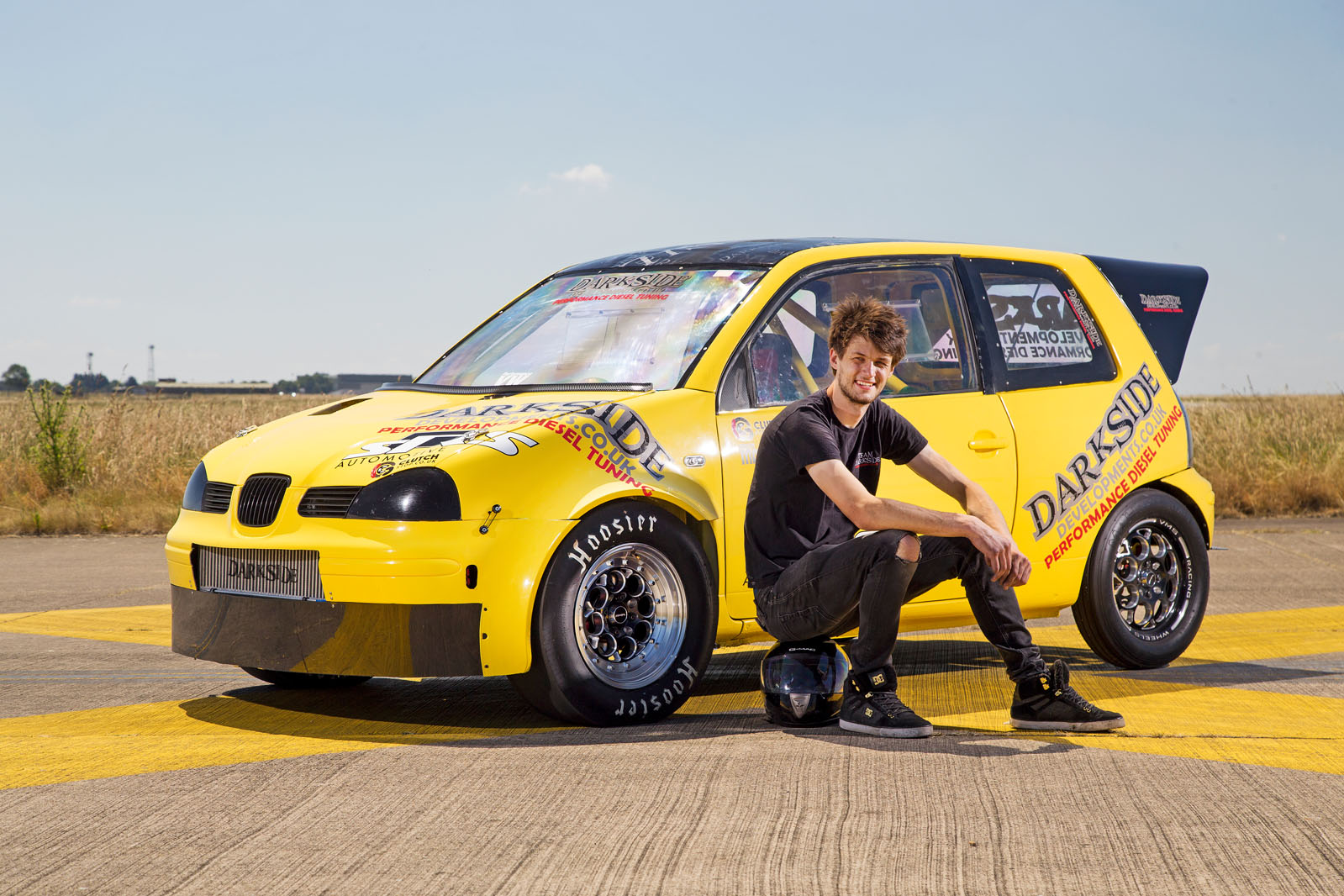
Darkside Developments built this car to push the boundaries of what could be achieved with a four-cylinder diesel engine. The base unit is a 2.0-litre common-rail lump, uprated in just about every way imaginable.
With a Borg Warner turbocharger from a John Deere combine harvester, which boosts at an astonishing four bar, the engine develops 550bhp and 650lb ft. The exhaust runs right out through the bonnet and every time Lynas builds the engine revs, a thick, acrid plume of smoke bursts into the air like ash erupting from a volcano.
With all that power and torque being sent to the front axle alone, the Arosa demands plenty of skill on the part of its driver. It’s all about managing the clutch release, reckons Lynas, although he points out that on a treated drag strip, the slick rubber does find enormous traction. The Hoosier tyres are purpose-built for drag racing and they’re run at just 6psi. They’re so baggy, in fact, that once the car is up to speed, they expand in diameter by an inch and a half. As they grow taller, they also become narrower, which helps to reduce the car’s frontal area.
To add yet more power, the Arosa runs a nitrous system, which is programmed to release its payload into the cylinders only when the road speed, engine speed, gear and boost pressure are all just so. The faster the car goes, the more nitrous the system releases, which means the car seems to pull harder and harder as it races down the strip, according to Lynas. How fast is it? Despite running on a low-grip concrete runway rather than a sticky drag strip, it bested our long-term BMW M5 for a video recently.
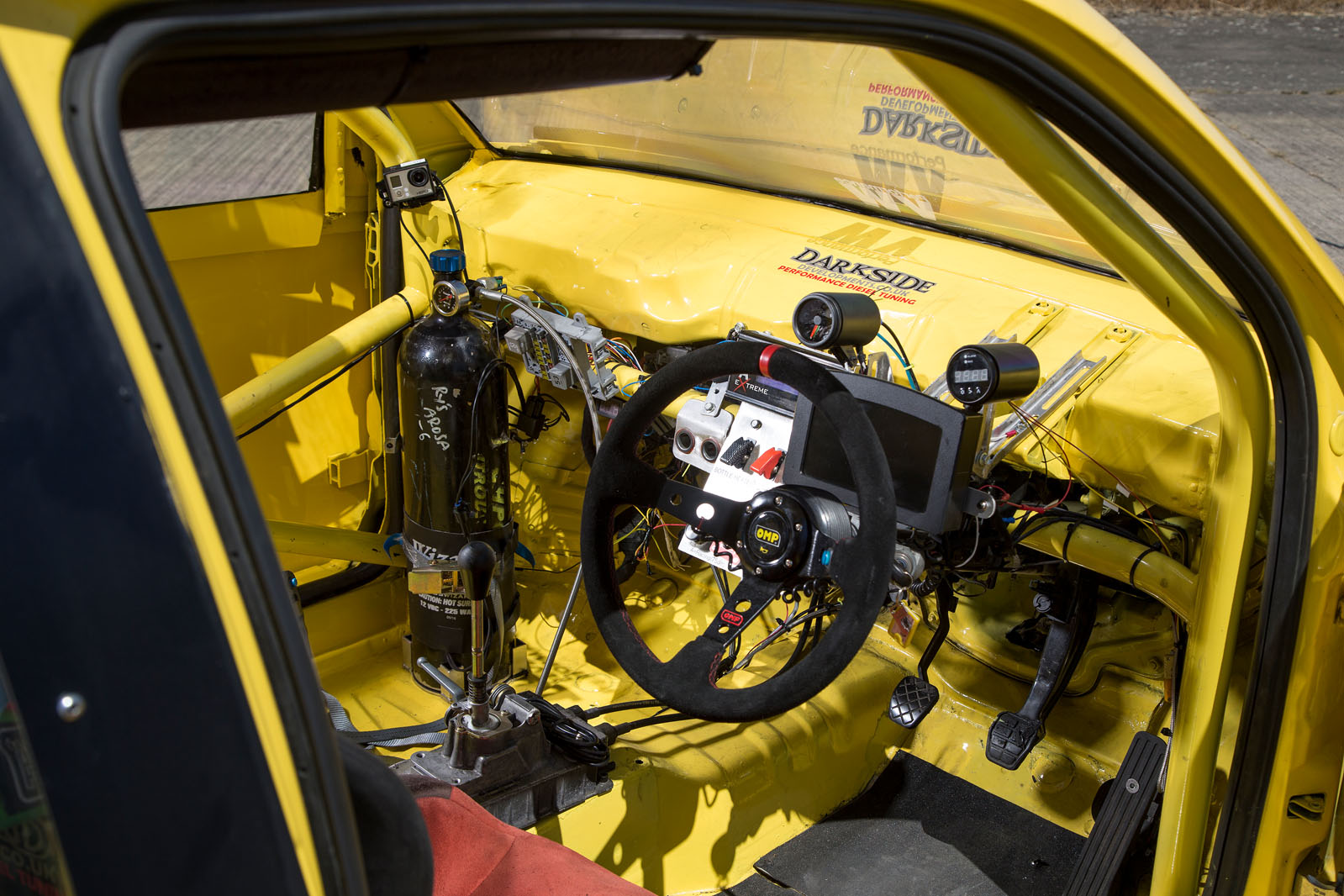
Twin motorcycle-engined MK:
“If you poured a bag of peanuts into the engine bay, I don’t think a single one of them would hit the floor,” comments Mathew Bennett. “It’s very snug in there.” Lotus Seven-type cars with motorcycle engines are scary machines. They weigh nothing at all and whip along at a frantic pace in bursts of peaky, inertia-free acceleration. I once frightened myself half to death driving such a car on a greasy circuit, which means I’m now hardwired to find the prospect of that sort of machine being armed with not one motorbike engine but two of the things completely terrifying. To Bennett, though, it’s just an engineering challenge.
“I bought the two bike engines, took a load of steel off a rack and fabricated the chassis,” he says, matter-of-factly. “The clearances are tiny.”

The car started life as an MK (Essex-based MK Sportscars has been building Lotus Seven-type chassis since 2000), but its engine bay had to be reconfigured to accept the two 998cc Kawasaki ZX-10R motors. The key component is the transfer case, which sits in the transmission tunnel and synchronises drive from the two power units before sending it via a conventional prop shaft to the rear axle. The transfer case had been built years before and had been gathering dust on a shelf at Tiger Racing until Bennett came calling. “Tiger sold me the case and I was away,” he says. The two engines develop 181bhp apiece, giving Bennett’s car a total of 362bhp. Weighing not much more than 500kg, it’s more accelerative through the gears than most supercars. “It’s only been on the road a few months. I go and get eggs and milk in it now.”
Already, though, Bennett is looking to sell up and move on to the next project: he wants more power still. (As you will have worked out, Bennett isn’t easily fazed. He was once a Wall of Death motorcycle rider, after all.)
“I want the next car to be based on a Caterham SV chassis,” he says, “with a pair of turbocharged Suzuki Hayabusa engines. One will drive the rear axle. One will drive the front. Those engines can produce 400bhp reliably, or 500bhp not so reliably. I might go down the 500bhp route.
Then I’ll have 1000bhp in a car weighing 500kg. There’s got to be a power-to-weight world record in that, hasn’t there?”
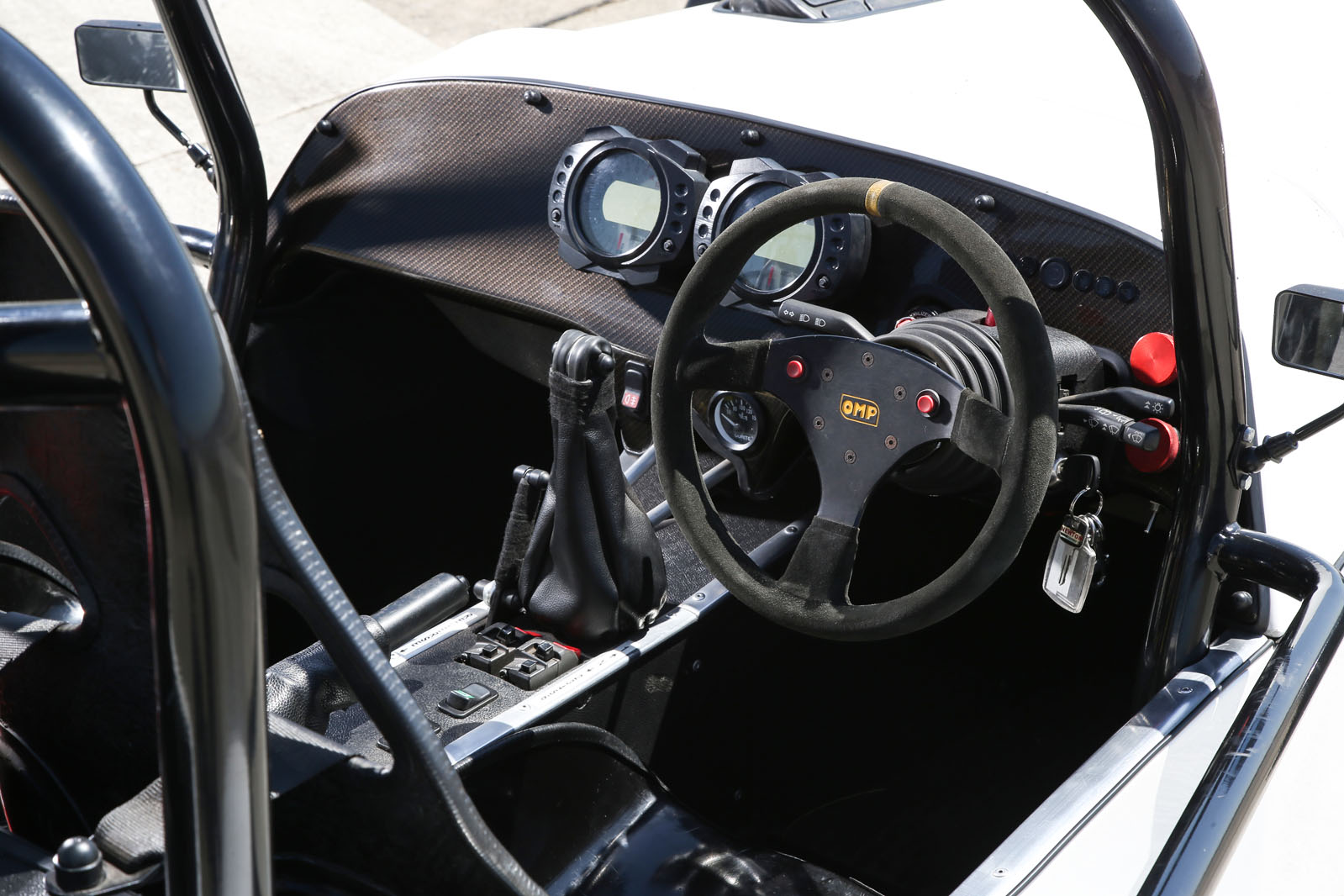
VW Golf Mk2 ’Ring weapon:
“If I had known the project was going to come this far,” says Nigel Pinder, “I never would have started with a Mk2 Golf CL.” He bought his first track car in 2005 after visiting the Nürburgring for the first time and immediately falling in love with the place. Pinder completed 35 laps of the Nordschleife one Easter in his track-prepared Volkswagen Mk2 Golf but crashed on the 36th tour and wrote it off.
His second Mk2 Golf was not much more than a rolling shell when he bought it a few weeks later. Over the following decade or so, that car has gradually evolved. Actually, it would be more accurate to say it has metamorphosed into a new creature altogether. It now has a 330bhp turbocharged engine, an aggressive plated differential, functional aero, racing slicks and track suspension (with spring rates that were specified by Jaguar XE SV Project 8 lead engineer David Pook no less). Having raced against Pinder’s freakish Golf at the Nürburgring, I can confirm that it is very nearly as fast around the circuit as a Porsche 911 GT3 RS... He recalls: “When I first went there with the second Golf 11 years ago, I did a few laps, had some fun and thought: ‘The brakes could be better.’ And so it all began.”
One of the first upgrades was a homemade front splitter. Pinder went to a track day at Silverstone to test his handiwork and almost spun the car at the high-speed Copse corner. “That’s when I realised these things need to be balanced front to rear,” he says.
 Over time, Pinder educated himself in the dark art of vehicle aerodynamics. After his frightening moment at Copse, he decided to fit a rear lip spoiler, then a bigger front splitter, then side skirts, then a flat floor, then a bigger rear wing and eventually a diffuser. He made all of it himself: “I tested everything using little tufts of wool to see which way the airflow was going. The rear diffuser that’s on there now was my second attempt at fibreglassing. They reckon seven degrees of rake is as much as you want on a non-aero car like mine.”
Over time, Pinder educated himself in the dark art of vehicle aerodynamics. After his frightening moment at Copse, he decided to fit a rear lip spoiler, then a bigger front splitter, then side skirts, then a flat floor, then a bigger rear wing and eventually a diffuser. He made all of it himself: “I tested everything using little tufts of wool to see which way the airflow was going. The rear diffuser that’s on there now was my second attempt at fibreglassing. They reckon seven degrees of rake is as much as you want on a non-aero car like mine.”
Pinder’s Golf has visited just about every circuit in the UK, but it’s spent most of its life at the ’Ring. He reckons it’s now done 2300 laps. That’s 30,000 miles on the Nordschleife alone.
Skoda Citigo track car:
“The goal for our Skoda Citigo track car was pretty simple,” says Darkside Developments founder Ryan Parkin. “We wanted to take it on track days with all the Ferraris and Porsches and just, you know, annoy them.”
The tiny silver hatch has the speed to do just that. It weighs no more than 1160kg, it’s four-wheel drive and, with nitrous, it has 346bhp and 425lb ft of torque. Probably best just to get out of its way, then.
Parkin founded Darkside Developments in 2010 having found his way – by chance, as much as anything – into tuning diesel-powered VW Group models, fabricating new components for them and shipping parts to the US.
Today, the Barnsley-based company has a staff of 20 and an annual turnover to make your eyes water. Parkin says the Citigo is part promotional tool and part rolling test bed, and there might even be some truth in that. You get the sense, however, that he and his colleagues built this pugnacious little thug just for the fun of it. “We needed a new project car,” he says, “and we spoke about building a Seat Mii with two engines.
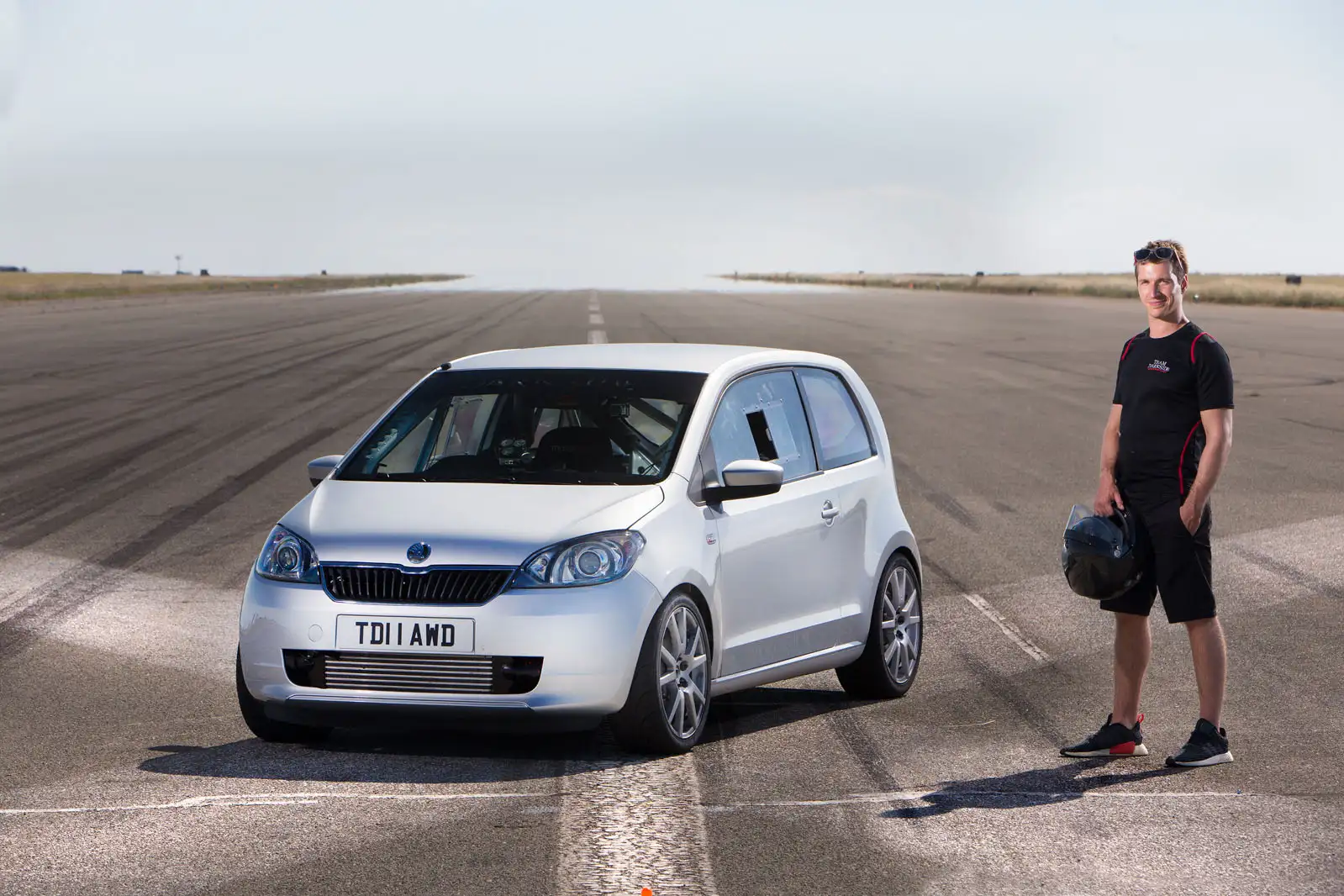
But then we found an unfinished four-wheel-drive Citigo, and it was just the thing.” It uses a Mk1 Audi TT four-wheel drive system, hacked this way and that to fit the Citigo’s minuscule wheelbase, and a sequential gearbox. The suspension components are all borrowed from a number of different Volkswagen Golfs, while both subframes are custom-built. Within the cabin, there’s an FIA-spec roll cage, and the dashboard has even been reshaped so you can see over it while sat in those very low-set racing seats.
“The brief for the engine was as close to 400bhp as possible but with as little smoke as possible,” says Parkin. “A big cloud of diesel smoke can look good in photos, but you really don’t want it in your face.” The basic 2.0-litre 16-valve lump has been completely reworked with new internals, uprated cooling hardware, custom intake and exhaust systems and a Garrett turbocharger.
“We’re going to thrash the life out of it on track and find out what breaks,” Parkin says. “We’re inspecting components all the time, so we’ll learn what is and what isn’t going to be reliable.” While upsetting Ferrari and Porsche drivers, of course.

Vauxhall VX220 baby supercar:
“I did the deal on the VX220 from a hospital bed while recovering from a broken neck,” Graeme Lambert recalls. Five years ago, he was hit from behind while stationary in a Lotus Elise. Most people would swear off insubstantial British sports cars for life in those circumstances, but Lambert is made of sterner stuff.
Lambert had owned a Vauxhall VX220 Turbo before the accident. He says: “I tuned it a bit and enjoyed it, but I struggled on track days with the spiky power delivery. I decided a supercharger was the way to go on the next car.” Within weeks of leaving the hospital, work had begun. “What I set out to achieve certainly wasn’t what you see before you now,” adds Lambert. “I thought it would be a much shorter, less expensive project.” Nonetheless, he wanted his car to be faster than a standard VX220 Turbo, with upwards of 300bhp.
The donor car’s original engine was well past its best and not fit for big power upgrades, so Lambert was on the lookout for a new motor. When Saab went bust in 2012 and the liquidators were busy selling assets, Lambert – a lifelong Saab devotee – bought a brand-new four-cylinder engine and had it shipped to his mechanic: “He did what all good mechanics do and dangled the carrot of a larger-capacity supercharger in front of me. The car now has forged pistons, stage-two camshafts, a lightened flywheel and so on. It’s up at around 346bhp now. The power delivery is really smooth, exactly what I wanted. It’s a road car as much as a track car and I commute to work in it fairly often.”
Just about everything else has been uprated over standard specification: the front brakes are four-pot AP items; the dampers, wheel geometry and front anti-roll bar are all adjustable; the spring rates are custom; even the bodywork has been upgraded with a distinctive coupé conversion. Lambert’s car looks less like a VX220 now and more like a scaled-down supercar. What’s most remarkable about it, though, is its engine bay, which is lined in heat-ref lective gold foil. Yep, just like a McLaren F1.
“I did my first track day for five years in this car a couple of weeks ago,” Lambert adds. “It was great to hang out with like-minded friends. The community is what it’s all about.”
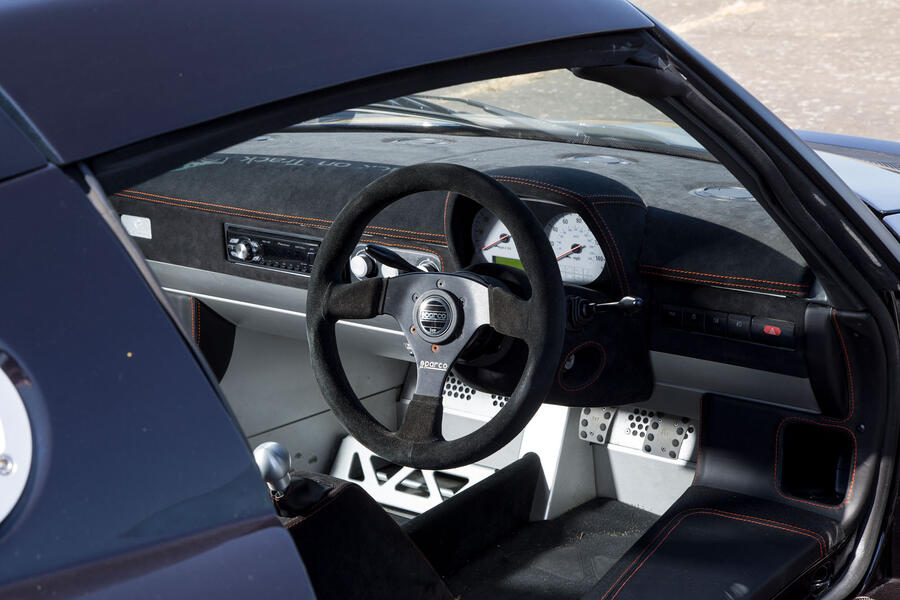
What’s the appeal?
What is it that compels a person to spend bundles of money and an enormous amount of time building a one- off project car? They’re hardly ever worth the money invested in them, after all, and as Graeme Lambert, owner of the VX220, points out, there will always be something that’s waiting to be fixed.
For most people, it seems to come down to one of two things. First of all, there is a natural curiosity; a need to know whether or not something is technically possible. Second, there is the matter of individuality. For many project car builders, the very idea of driving something that anybody else can walk into a showroom and buy is utterly unthinkable.
“I think about what else I could have bought every day,” comments Lambert. “I’ve spent somewhere between £30,000 and £40,000 on my VX220. I could have gone out and bought some serious cars with that, but I’ve only been able to spend that much because the project has happened over time. Plus, my car is completely individual.”
For the guys from Darkside Developments, their project cars are promotional tools and rolling test beds, but for Mathew Bennett, his motivation was rather less exact. “I’ve proven you can put two bike engines in a car,” he says. “I want to do the next project [a 1000bhp Caterham] because a few people I’ve spoken to about it have said it cannot be done. I want to find that out for myself.”
There is a third reason, of course: love. “I don’t have any formal training in this so I’ve been learning as I go,” says Nigel Pinder. His Golf project “has been a pain at times, but I’ve loved every minute of it”.

Five mad one-off creations to buy on the PistonHeads classifieds:
SUBARU IMPREZA TURBO 2000 - A road-legal Time Attack car, this Impreza produces up to 700bhp. According to the ad, it was built over a five-year period with receipts totalling £60,000. It has anti-lag, just like a World Rally Car, and a billet turbo. Price: £25,000
VAUXHALL VXR8 - With 587bhp, the most powerful factory-specification VXR8, the GTS-R of 2017, was absurdly fast. Quite what a VXR8 with 705bhp must feel like is anybody’s guess. The seller reckons it’s good for 200mph and cost £60,000 to build. Price: £28,950
FORD MUSTANG GT - How much power can you get for less than £50,000? As much as a McLaren Senna, apparently. Modified with a high-capacity Whipple supercharger, this Mustang V8 produces 800bhp. The chassis has been uprated with KW coil-overs too. Price: £42,500
NISSAN 200SX - Described in the adas “a race car and not a show car”, this S15-generation 200SX has close to 500bhp and an aero kit to shame a Pikes Peak contender. Still road legal, it was built by Kent- based MnM Engineering. Price: £15,500
VOLKSWAGEN GOLF VR6 4MOTION MK4 - Having started life as a VR6 4Motion with 204bhp, this Mk4 Golf now has more than twice the output its maker intended. A Rotrex supercharger and various intake and exhaust modifications boost power to 412bhp. Price: £13,350
Read more
The fastest cars around the Autocar handling circuit
Comments
Post a Comment